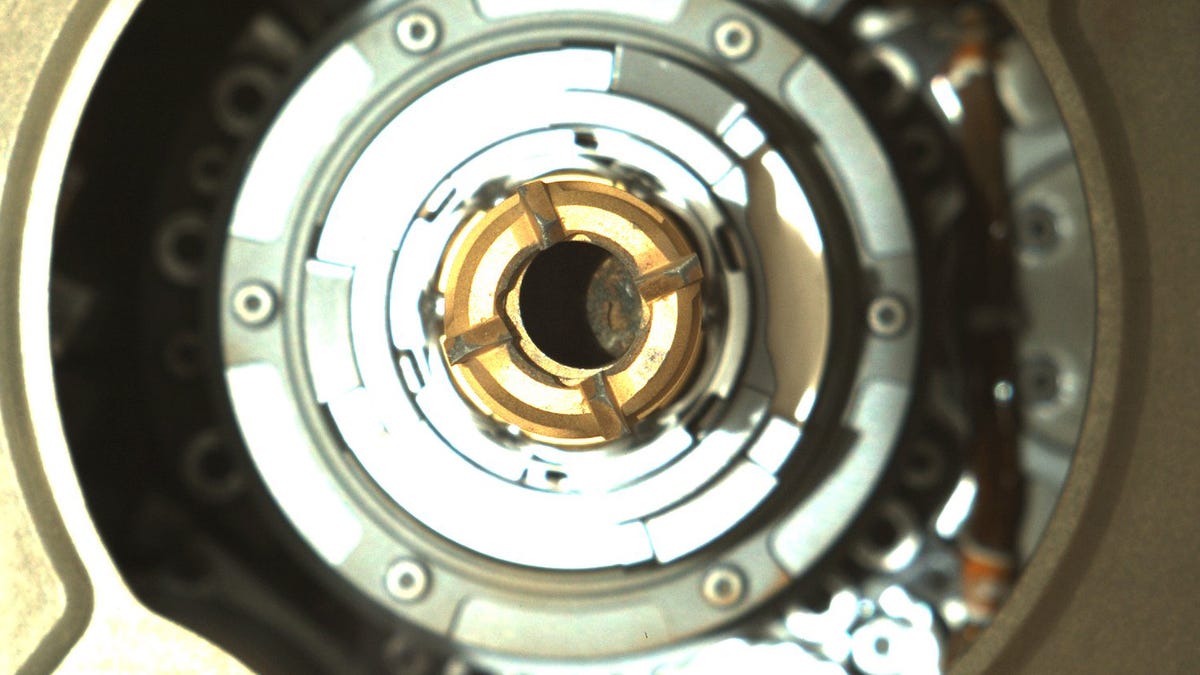'A historic moment': NASA Perseverance rover collects first ever Mars rock sample
The rock core could be destined for Earth eventually, but mailing it home will be a whole other ordeal.

NASA's Perseverance rover has confirmed it: There's Martian rock in that tube!
NASA's Perseverance rover, currently rolling around a dried-out lakebed on Mars, has completed the first, critical step in a decade-long mission to return pieces of Mars to Earth. On the 190th day of its mission, "Percy," as the rover is affectionately known, overcame earlier sampling problems and snatched a core of rock, slightly thicker than a pencil, from Mars' surface.
On Sept. 1, the space agency announced that data had arrived from the Mars rover indicating it had obtained a core from a briefcase-sized rock known as "Rochette." But the team, ever the diligent scientists, wanted to be "extra certain" that was the case. To be sure, the rover would need to take a few photographs of the drill device with one of its cameras and get a few more shots of the rock sample it had drilled.
The first images beamed back to Earth appeared to show rock had been snatched. However, after an operation to vibrate the drill bit, Perseverance took a second round of images, and the sun wasn't playing nice. The lighting conditions were too poor to confirm exactly what was in the tube -- and the team wanted to be doubly sure.
On Saturday, they got their wish.
I’ve got it! With better lighting down the sample tube, you can see the rock core I collected is still in there. Up next, I’ll process this sample and seal the tube. #SamplingMars
— NASA's Perseverance Mars Rover (@NASAPersevere) September 5, 2021
Latest images: https://t.co/Ex1QDo3eC2 pic.twitter.com/gumqpmoXBW
Adam Steltzner, NASA chief engineer on the mission, tweeted his congratulations on Sep. 4. "We got it," he wrote.
The early images show a rust-red sediment that could be iron-rich minerals, according to Steven Ruff, a planetary geologist at Arizona State University and creator of YouTube channel Mars Guy. Percy's landing site in Jezero Crater was once home to a great body of water, and its two sampling attempts are already revealing some of the geologic history of Mars. "Both of those rock targets that they've interrogated look different than really anything that we've seen anywhere else on Mars," Ruff says.
The rock core is visible in the center ring, locked away inside the titanium collection tube. This image was taken on Sept. 6, 2021, just before Percy capped and sealed the sample away.
Getting the Martian rock core in the sampling tube is like placing a letter in an envelope. The next step is for Perseverance to process, seal and stamp that envelope and get it ready to send. Perseverance has 43 of these envelopes and can collect dozens of diverse rock samples. The diversity will be key -- enabling the science team to compare rocks from across Jezero crater, learning more about Mars' history and, potentially, whether life existed on the planet.
On Monday, NASA announced that the rover had stored the sample in its interior, locked away in an airtight titanium tube. (I'm sure this will become a trivia question in the future so, for reference, the very first sample was stored in tube number 266.) This was the moment the team was waiting for, with one last maneuver required to show the robot's complex sampling mechanism worked. And it worked flawlessly.
"For all of NASA science, this is truly a historic moment," said Thomas Zurbuchen, NASA's associate administrator for science, on Monday.
The collection is part one of the most elaborate and complex mail run of all time.
Percy intends to leave these titanium tube-letters scattered across the surface of Mars for a mail carrier to collect at a later date. The key issue here is: The mail carrier hasn't even been built yet.
NASA and the European Space Agency plan to send a Martian lander and sample collection rover to the surface of Mars in 2026. The rover (our mail carrier in this extended metaphor) will roll out, gather up Percy's tubes and place them in its mailvan -- a rocket bound for Earth. Sometime in early 2030, Percy's mail will finally reach its intended recipient, provided everything goes according to plan.
Should the mail make it home, it would be the first time humans have returned materials from another planet.

